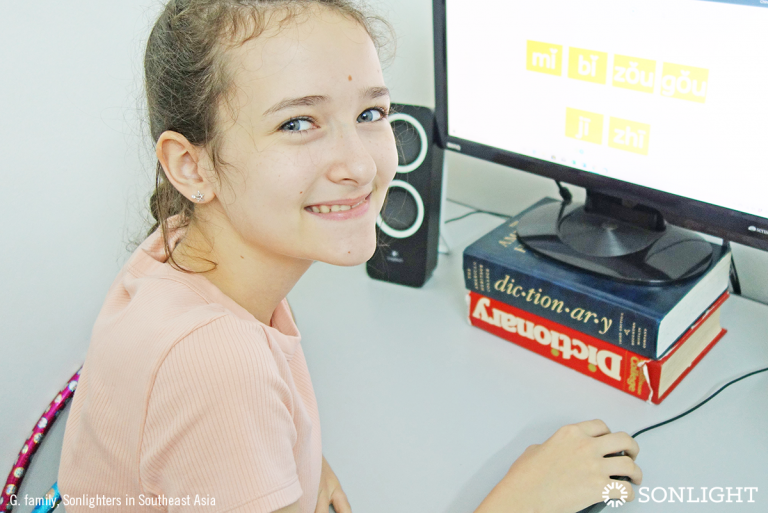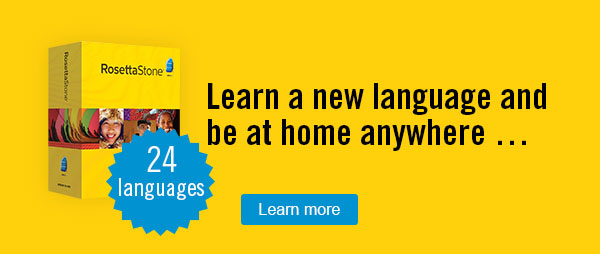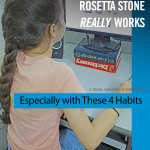
You’ve decided to add a foreign language to your collection of homeschool electives and have invested in Rosetta Stone at Sonlight’s recommendation.
Where do you go from here?
How can you maximize your investment? Is there anything you can do to ensure that the hours your child spends using Rosetta Stone will translate into usable and lasting language knowledge? Does Rosetta Stone really work?
Yes, the program itself is engaging and teaches practical spoken language skills, but, like any tool, there are techniques and habits that lead to success.
1. Use the Program Regularly
We all know the effects of summer slide are real. That’s why some homeschool families, like my own, have opted for year-round schooling with short breaks at irregular times of year. After a long break from math or reading, children might need a lot of review for things they've forgotten.
The same effect happens when learning foreign languages. Only in this area, the effects of irregular study seem to be even more dramatic.
And...let’s be honest, when life gets busy, electives tend to be the first courses to fall by the wayside. If you’re finding that your child is constantly needing to review the same lesson or is not able to retain vocabulary, ensure they are using Rosetta Stone regularly each school day.
If little progress is being made, switch foreign language study to earlier in the school day. It is less necessary to spend large amounts of time on the program each day than it is to be consistent with daily exposure. Even 15 or 20 minutes on a daily basis has great effect in building confidence with using the target language.
2. Repeat the Vocabulary Out Loud
Because it's an online program, your child can use Rosetta Stone anywhere there is access to an internet-connected device and a pair of earbuds. However, as much as possible, opt to use Rosetta Stone in a non-public location where it’s okay to speak out loud without disturbing others (or feeling awkward).
Rosetta Stone uses TruAccent® technology in pronunciation activities to help your child practice accurate pronunciation and get instant feedback. In reality, though, so much of language learning is retained through vocal repetition, that I recommend making a habit of always repeating the phrases being learned after the voice reads them out, instead of only during the specific pronunciation exercises.
The more practice, the more muscle memory develops, and the more chances to develop accurate pronunciation. This will be especially crucial when learning languages that have sounds which don’t exist in English (or their own native language). I highly recommend not limiting pronunciation practice only to the sections of the lesson which are testing pronunciation, but simply developing a habit of repeating after the recorded voice each and every time.
3. Practice Writing New Vocabulary by Hand
One of the most fantastic aspects of the Rosetta Stone program is that it’s completely online—no bulky textbooks needed. However, the solely digital factor can be a problem when studying a language that has a different alphabet or writing system than the one your student already knows.
Rosetta Stone does a good job of tackling language learning from every direction:
- listening
- speaking
- reading
- writing
- grammar
- vocabulary
But particularly if you have chosen a language such as Mandarin, Japanese, Korean, Hindi, or another language with a writing system other than the Latin alphabet used in English, I recommend seeking additional resources for writing practice.
In my own homeschool, we use Rosetta Stone for studying Mandarin Chinese. Chinese characters are introduced and practiced in the program, but we don’t rely on this program alone to master the language. Learning to read and write effectively in Mandarin takes practice beyond what a computer program can offer; the etymology of characters and careful practice of neat calligraphy and stroke order are not part of Rosetta Stone. The best way to remember how to write Chinese characters, in my experience, is that, after they have been learned, to write them, stroke by stroke, again and again, in a variety of sentences, building muscle memory and the experience of writing.
If you find that your child’s conversational and comprehension skills are advancing more quickly than his or her writing skills in the target language, have them spend some time with paper and pencil on a regular basis, practicing putting their new language on paper and getting the hang of the way it’s written.
4. Use the Language While Away from the Computer Screen
Sometimes our brains put the things we learn into boxes of sorts. If a child enjoys studying language with Rosetta Stone but doesn’t have any experience with the language in any other way or at any other time, the knowledge may be stuck in the mental Rosetta Stone box. As a result, they will struggle to apply vocabulary correctly in other experiences outside using the program.
Very early in language learning, ask them to keep an eye open for examples of the language in everyday life. Since our homeschool is studying Mandarin with Rosetta Stone, I ask the girls if they recognize any characters they’ve learned on restaurant menus or local signs, because we live in a region where written Chinese is commonly seen around town. We’ll watch children’s TV shows in Mandarin, read simple books, and randomly quiz each other during the day.
Teach your child to keep their eyes and ears open for opportunities to engage with the content they’ve learned. I’ve found that they tend to see what they’re looking for.
Foreign language skills, when thoroughly acquired and allowed the opportunity to remain sharp instead of growing rusty, can accompany your child throughout their life and give them opportunities in career, ministry, and relationship that they could never have experienced without such skills. Rosetta Stone, when used to its maximum potential, provides an amazing jumping-off point into the world of speaking a new language!
Choose from 24 languages and add foreign language to your homeschool lineup today.








